Leading and Managing Organizational Resources: MBA Design Partnership
VerifiedAdded on 2023/06/03
|13
|3217
|77
Report
AI Summary
This report analyzes the leading and managing of organizational resources within the context of MBA Design Partnership, a growing SME architecture practice. It examines challenges related to rapid growth, strategic and operational leadership, and the integration of academic approaches. The report assesses the company's management-driven organization, its use of management tools like SCRUM and TRELLO, and its core values. It further explores how the MBA Design Partnership can leverage its human capital and become a learning organization, while also addressing the measurement of productivity in a creative environment and strategies for improvement. The report also touches upon hyper-converged infrastructure and its impact on performance and productivity.
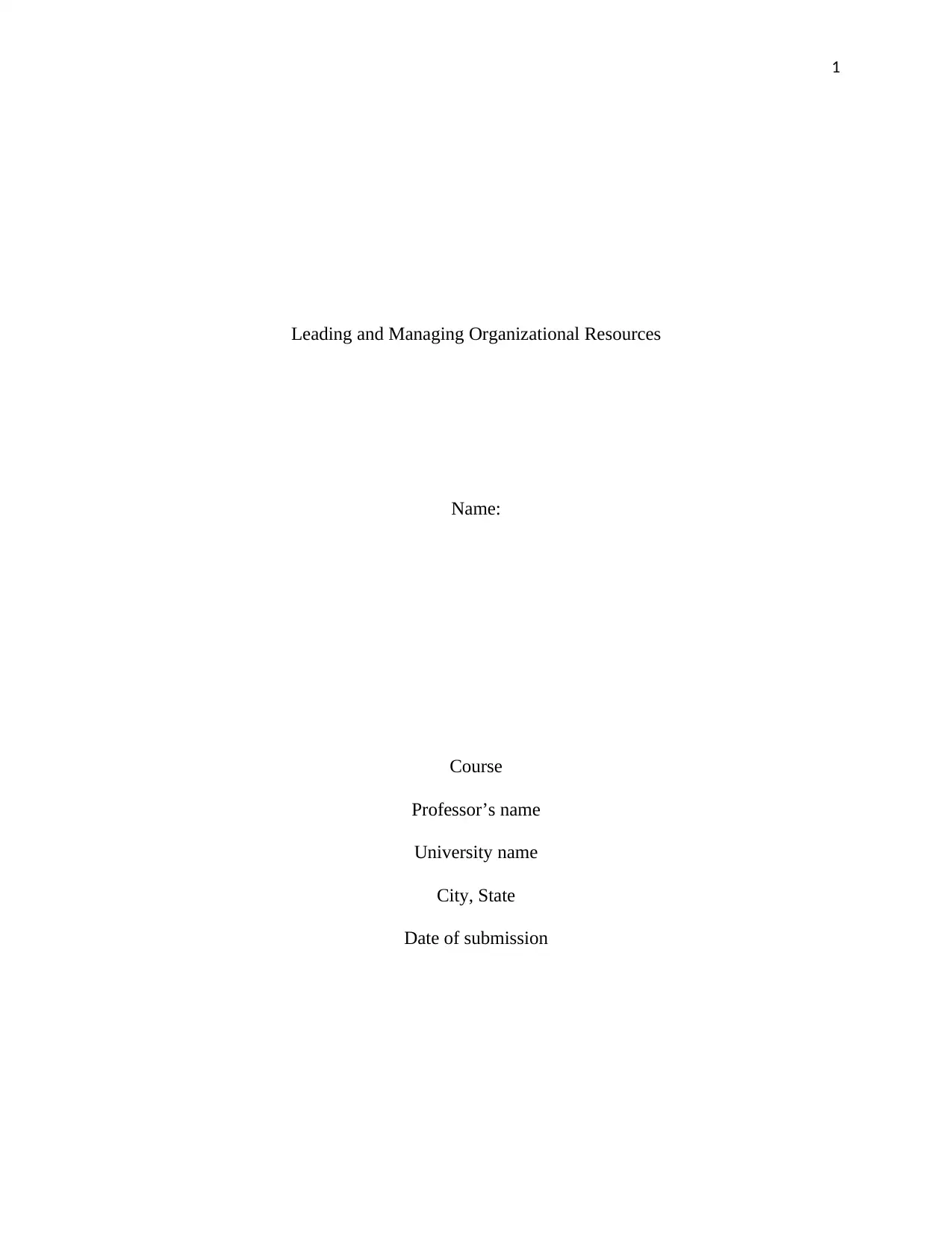
1
Leading and Managing Organizational Resources
Name:
Course
Professor’s name
University name
City, State
Date of submission
Leading and Managing Organizational Resources
Name:
Course
Professor’s name
University name
City, State
Date of submission
Paraphrase This Document
Need a fresh take? Get an instant paraphrase of this document with our AI Paraphraser
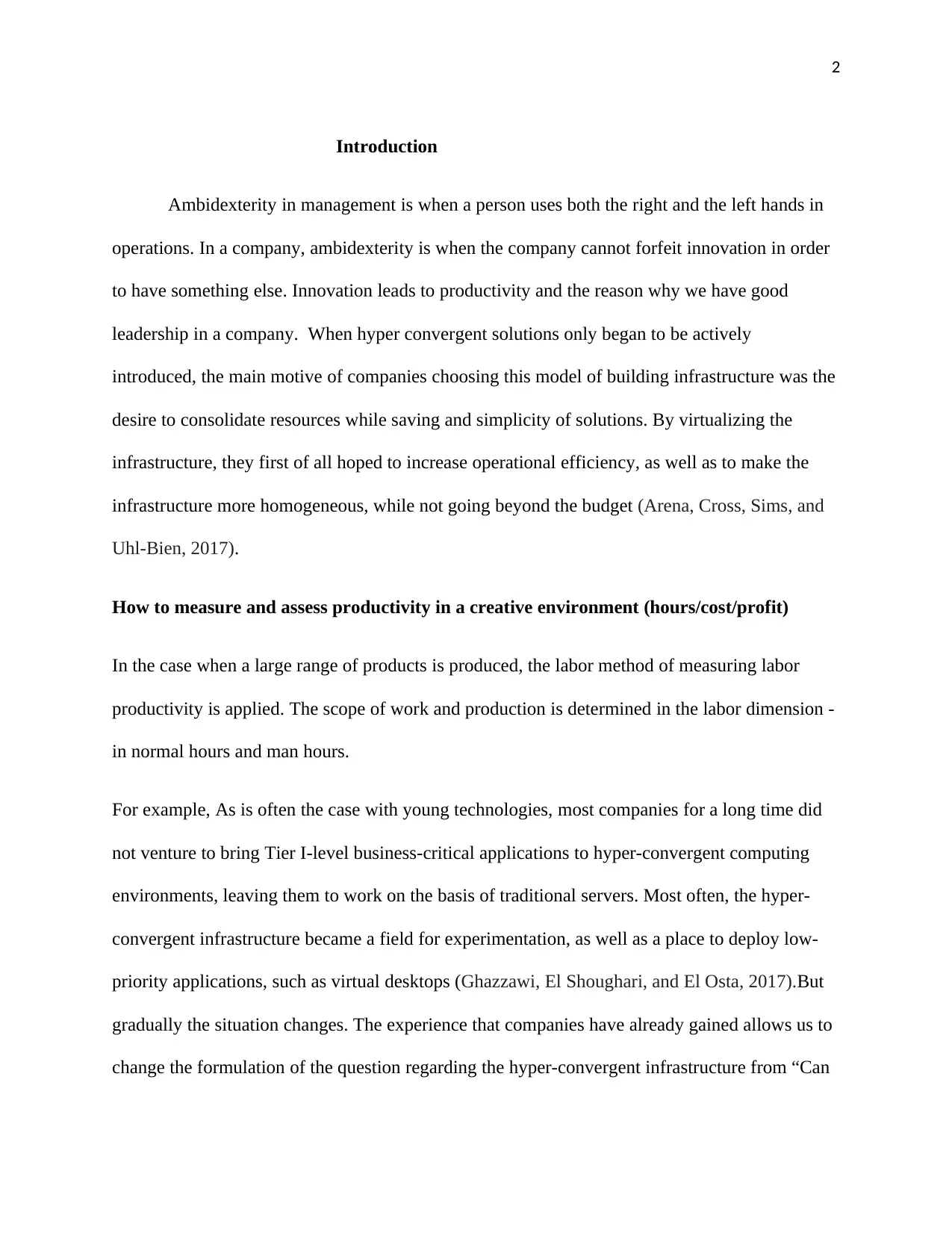
2
Introduction
Ambidexterity in management is when a person uses both the right and the left hands in
operations. In a company, ambidexterity is when the company cannot forfeit innovation in order
to have something else. Innovation leads to productivity and the reason why we have good
leadership in a company. When hyper convergent solutions only began to be actively
introduced, the main motive of companies choosing this model of building infrastructure was the
desire to consolidate resources while saving and simplicity of solutions. By virtualizing the
infrastructure, they first of all hoped to increase operational efficiency, as well as to make the
infrastructure more homogeneous, while not going beyond the budget (Arena, Cross, Sims, and
Uhl-Bien, 2017).
How to measure and assess productivity in a creative environment (hours/cost/profit)
In the case when a large range of products is produced, the labor method of measuring labor
productivity is applied. The scope of work and production is determined in the labor dimension -
in normal hours and man hours.
For example, As is often the case with young technologies, most companies for a long time did
not venture to bring Tier I-level business-critical applications to hyper-convergent computing
environments, leaving them to work on the basis of traditional servers. Most often, the hyper-
convergent infrastructure became a field for experimentation, as well as a place to deploy low-
priority applications, such as virtual desktops (Ghazzawi, El Shoughari, and El Osta, 2017).But
gradually the situation changes. The experience that companies have already gained allows us to
change the formulation of the question regarding the hyper-convergent infrastructure from “Can
Introduction
Ambidexterity in management is when a person uses both the right and the left hands in
operations. In a company, ambidexterity is when the company cannot forfeit innovation in order
to have something else. Innovation leads to productivity and the reason why we have good
leadership in a company. When hyper convergent solutions only began to be actively
introduced, the main motive of companies choosing this model of building infrastructure was the
desire to consolidate resources while saving and simplicity of solutions. By virtualizing the
infrastructure, they first of all hoped to increase operational efficiency, as well as to make the
infrastructure more homogeneous, while not going beyond the budget (Arena, Cross, Sims, and
Uhl-Bien, 2017).
How to measure and assess productivity in a creative environment (hours/cost/profit)
In the case when a large range of products is produced, the labor method of measuring labor
productivity is applied. The scope of work and production is determined in the labor dimension -
in normal hours and man hours.
For example, As is often the case with young technologies, most companies for a long time did
not venture to bring Tier I-level business-critical applications to hyper-convergent computing
environments, leaving them to work on the basis of traditional servers. Most often, the hyper-
convergent infrastructure became a field for experimentation, as well as a place to deploy low-
priority applications, such as virtual desktops (Ghazzawi, El Shoughari, and El Osta, 2017).But
gradually the situation changes. The experience that companies have already gained allows us to
change the formulation of the question regarding the hyper-convergent infrastructure from “Can
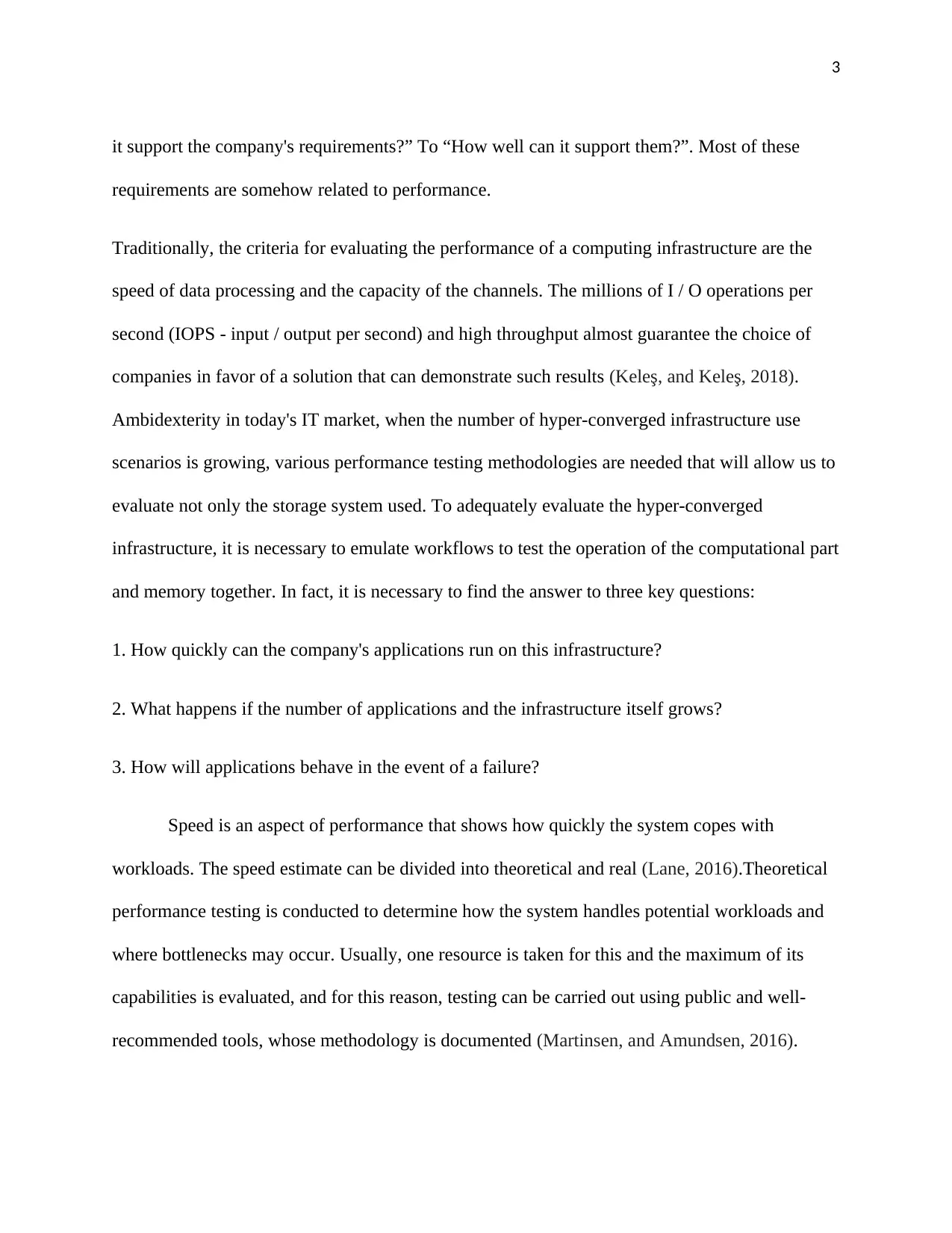
3
it support the company's requirements?” To “How well can it support them?”. Most of these
requirements are somehow related to performance.
Traditionally, the criteria for evaluating the performance of a computing infrastructure are the
speed of data processing and the capacity of the channels. The millions of I / O operations per
second (IOPS - input / output per second) and high throughput almost guarantee the choice of
companies in favor of a solution that can demonstrate such results (Keleş, and Keleş, 2018).
Ambidexterity in today's IT market, when the number of hyper-converged infrastructure use
scenarios is growing, various performance testing methodologies are needed that will allow us to
evaluate not only the storage system used. To adequately evaluate the hyper-converged
infrastructure, it is necessary to emulate workflows to test the operation of the computational part
and memory together. In fact, it is necessary to find the answer to three key questions:
1. How quickly can the company's applications run on this infrastructure?
2. What happens if the number of applications and the infrastructure itself grows?
3. How will applications behave in the event of a failure?
Speed is an aspect of performance that shows how quickly the system copes with
workloads. The speed estimate can be divided into theoretical and real (Lane, 2016).Theoretical
performance testing is conducted to determine how the system handles potential workloads and
where bottlenecks may occur. Usually, one resource is taken for this and the maximum of its
capabilities is evaluated, and for this reason, testing can be carried out using public and well-
recommended tools, whose methodology is documented (Martinsen, and Amundsen, 2016).
it support the company's requirements?” To “How well can it support them?”. Most of these
requirements are somehow related to performance.
Traditionally, the criteria for evaluating the performance of a computing infrastructure are the
speed of data processing and the capacity of the channels. The millions of I / O operations per
second (IOPS - input / output per second) and high throughput almost guarantee the choice of
companies in favor of a solution that can demonstrate such results (Keleş, and Keleş, 2018).
Ambidexterity in today's IT market, when the number of hyper-converged infrastructure use
scenarios is growing, various performance testing methodologies are needed that will allow us to
evaluate not only the storage system used. To adequately evaluate the hyper-converged
infrastructure, it is necessary to emulate workflows to test the operation of the computational part
and memory together. In fact, it is necessary to find the answer to three key questions:
1. How quickly can the company's applications run on this infrastructure?
2. What happens if the number of applications and the infrastructure itself grows?
3. How will applications behave in the event of a failure?
Speed is an aspect of performance that shows how quickly the system copes with
workloads. The speed estimate can be divided into theoretical and real (Lane, 2016).Theoretical
performance testing is conducted to determine how the system handles potential workloads and
where bottlenecks may occur. Usually, one resource is taken for this and the maximum of its
capabilities is evaluated, and for this reason, testing can be carried out using public and well-
recommended tools, whose methodology is documented (Martinsen, and Amundsen, 2016).
⊘ This is a preview!⊘
Do you want full access?
Subscribe today to unlock all pages.

Trusted by 1+ million students worldwide
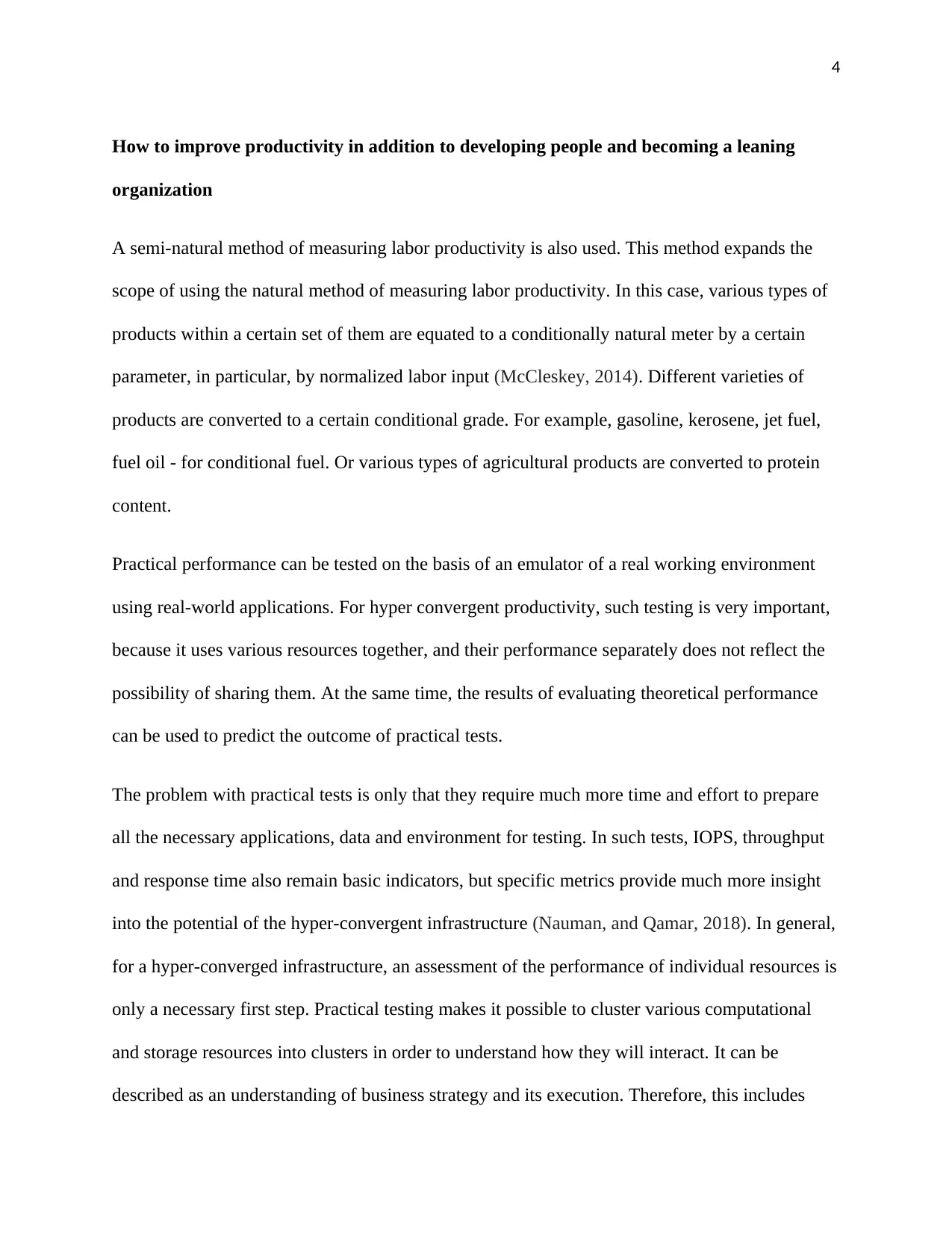
4
How to improve productivity in addition to developing people and becoming a leaning
organization
A semi-natural method of measuring labor productivity is also used. This method expands the
scope of using the natural method of measuring labor productivity. In this case, various types of
products within a certain set of them are equated to a conditionally natural meter by a certain
parameter, in particular, by normalized labor input (McCleskey, 2014). Different varieties of
products are converted to a certain conditional grade. For example, gasoline, kerosene, jet fuel,
fuel oil - for conditional fuel. Or various types of agricultural products are converted to protein
content.
Practical performance can be tested on the basis of an emulator of a real working environment
using real-world applications. For hyper convergent productivity, such testing is very important,
because it uses various resources together, and their performance separately does not reflect the
possibility of sharing them. At the same time, the results of evaluating theoretical performance
can be used to predict the outcome of practical tests.
The problem with practical tests is only that they require much more time and effort to prepare
all the necessary applications, data and environment for testing. In such tests, IOPS, throughput
and response time also remain basic indicators, but specific metrics provide much more insight
into the potential of the hyper-convergent infrastructure (Nauman, and Qamar, 2018). In general,
for a hyper-converged infrastructure, an assessment of the performance of individual resources is
only a necessary first step. Practical testing makes it possible to cluster various computational
and storage resources into clusters in order to understand how they will interact. It can be
described as an understanding of business strategy and its execution. Therefore, this includes
How to improve productivity in addition to developing people and becoming a leaning
organization
A semi-natural method of measuring labor productivity is also used. This method expands the
scope of using the natural method of measuring labor productivity. In this case, various types of
products within a certain set of them are equated to a conditionally natural meter by a certain
parameter, in particular, by normalized labor input (McCleskey, 2014). Different varieties of
products are converted to a certain conditional grade. For example, gasoline, kerosene, jet fuel,
fuel oil - for conditional fuel. Or various types of agricultural products are converted to protein
content.
Practical performance can be tested on the basis of an emulator of a real working environment
using real-world applications. For hyper convergent productivity, such testing is very important,
because it uses various resources together, and their performance separately does not reflect the
possibility of sharing them. At the same time, the results of evaluating theoretical performance
can be used to predict the outcome of practical tests.
The problem with practical tests is only that they require much more time and effort to prepare
all the necessary applications, data and environment for testing. In such tests, IOPS, throughput
and response time also remain basic indicators, but specific metrics provide much more insight
into the potential of the hyper-convergent infrastructure (Nauman, and Qamar, 2018). In general,
for a hyper-converged infrastructure, an assessment of the performance of individual resources is
only a necessary first step. Practical testing makes it possible to cluster various computational
and storage resources into clusters in order to understand how they will interact. It can be
described as an understanding of business strategy and its execution. Therefore, this includes
Paraphrase This Document
Need a fresh take? Get an instant paraphrase of this document with our AI Paraphraser
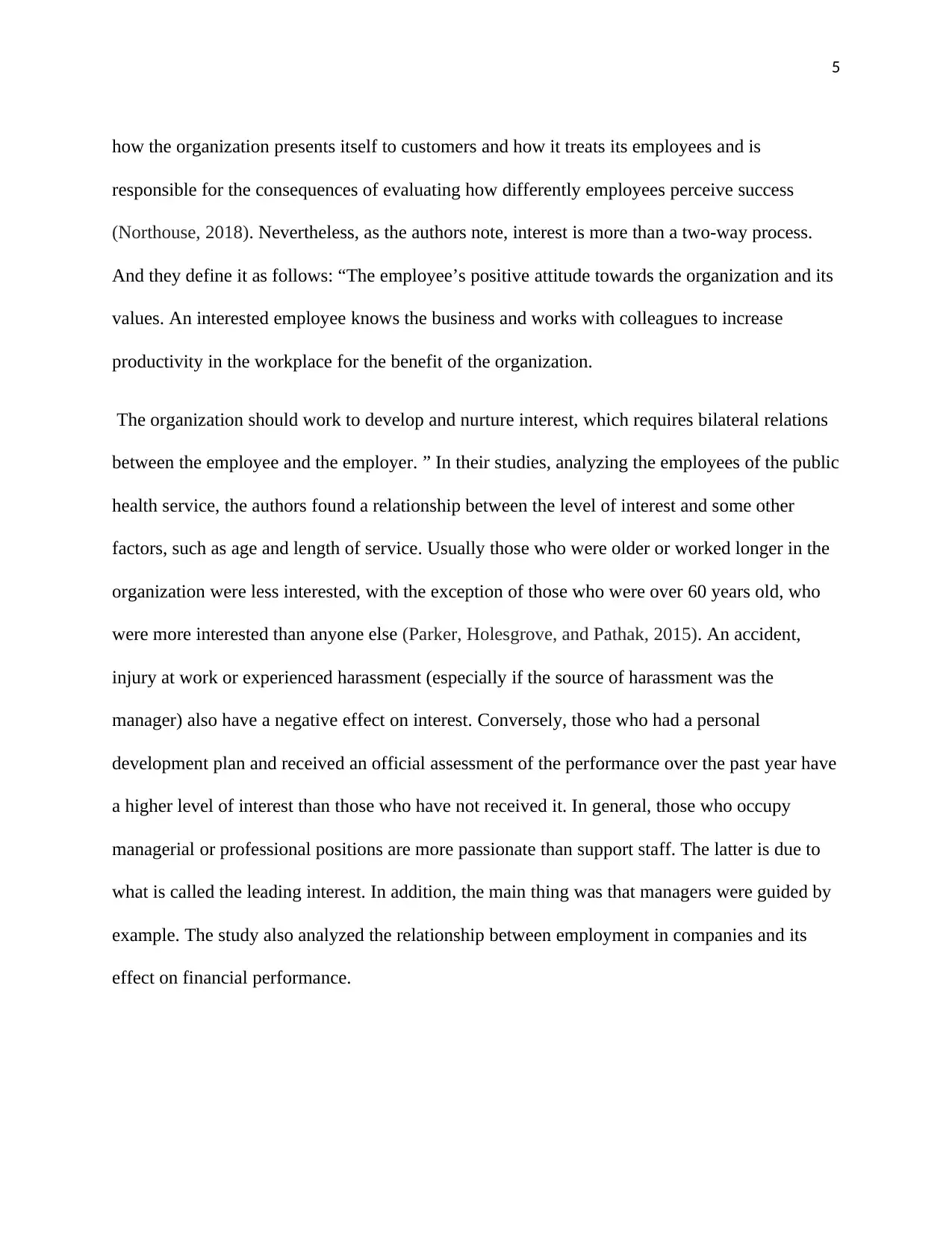
5
how the organization presents itself to customers and how it treats its employees and is
responsible for the consequences of evaluating how differently employees perceive success
(Northouse, 2018). Nevertheless, as the authors note, interest is more than a two-way process.
And they define it as follows: “The employee’s positive attitude towards the organization and its
values. An interested employee knows the business and works with colleagues to increase
productivity in the workplace for the benefit of the organization.
The organization should work to develop and nurture interest, which requires bilateral relations
between the employee and the employer. ” In their studies, analyzing the employees of the public
health service, the authors found a relationship between the level of interest and some other
factors, such as age and length of service. Usually those who were older or worked longer in the
organization were less interested, with the exception of those who were over 60 years old, who
were more interested than anyone else (Parker, Holesgrove, and Pathak, 2015). An accident,
injury at work or experienced harassment (especially if the source of harassment was the
manager) also have a negative effect on interest. Conversely, those who had a personal
development plan and received an official assessment of the performance over the past year have
a higher level of interest than those who have not received it. In general, those who occupy
managerial or professional positions are more passionate than support staff. The latter is due to
what is called the leading interest. In addition, the main thing was that managers were guided by
example. The study also analyzed the relationship between employment in companies and its
effect on financial performance.
how the organization presents itself to customers and how it treats its employees and is
responsible for the consequences of evaluating how differently employees perceive success
(Northouse, 2018). Nevertheless, as the authors note, interest is more than a two-way process.
And they define it as follows: “The employee’s positive attitude towards the organization and its
values. An interested employee knows the business and works with colleagues to increase
productivity in the workplace for the benefit of the organization.
The organization should work to develop and nurture interest, which requires bilateral relations
between the employee and the employer. ” In their studies, analyzing the employees of the public
health service, the authors found a relationship between the level of interest and some other
factors, such as age and length of service. Usually those who were older or worked longer in the
organization were less interested, with the exception of those who were over 60 years old, who
were more interested than anyone else (Parker, Holesgrove, and Pathak, 2015). An accident,
injury at work or experienced harassment (especially if the source of harassment was the
manager) also have a negative effect on interest. Conversely, those who had a personal
development plan and received an official assessment of the performance over the past year have
a higher level of interest than those who have not received it. In general, those who occupy
managerial or professional positions are more passionate than support staff. The latter is due to
what is called the leading interest. In addition, the main thing was that managers were guided by
example. The study also analyzed the relationship between employment in companies and its
effect on financial performance.
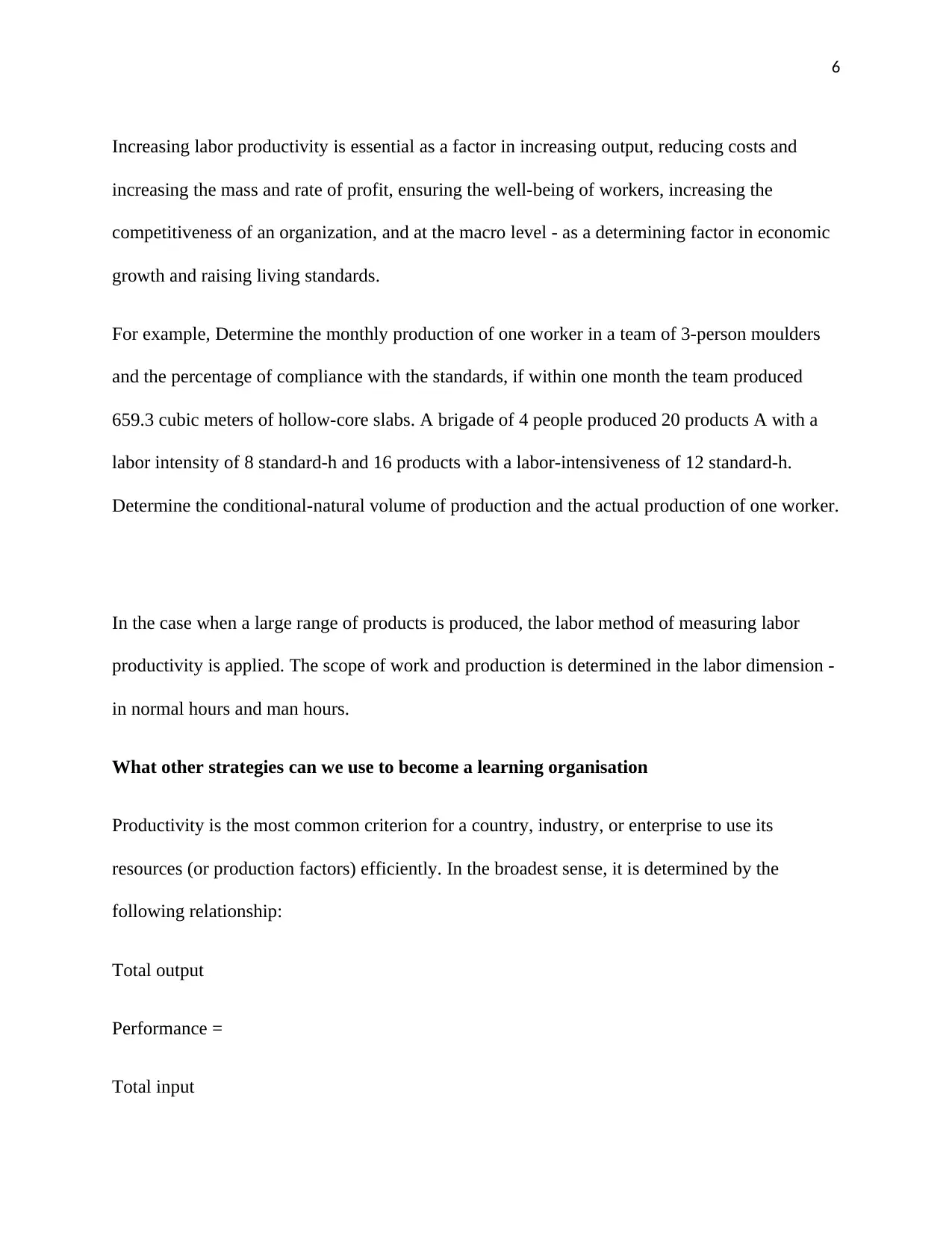
6
Increasing labor productivity is essential as a factor in increasing output, reducing costs and
increasing the mass and rate of profit, ensuring the well-being of workers, increasing the
competitiveness of an organization, and at the macro level - as a determining factor in economic
growth and raising living standards.
For example, Determine the monthly production of one worker in a team of 3-person moulders
and the percentage of compliance with the standards, if within one month the team produced
659.3 cubic meters of hollow-core slabs. A brigade of 4 people produced 20 products A with a
labor intensity of 8 standard-h and 16 products with a labor-intensiveness of 12 standard-h.
Determine the conditional-natural volume of production and the actual production of one worker.
In the case when a large range of products is produced, the labor method of measuring labor
productivity is applied. The scope of work and production is determined in the labor dimension -
in normal hours and man hours.
What other strategies can we use to become a learning organisation
Productivity is the most common criterion for a country, industry, or enterprise to use its
resources (or production factors) efficiently. In the broadest sense, it is determined by the
following relationship:
Total output
Performance =
Total input
Increasing labor productivity is essential as a factor in increasing output, reducing costs and
increasing the mass and rate of profit, ensuring the well-being of workers, increasing the
competitiveness of an organization, and at the macro level - as a determining factor in economic
growth and raising living standards.
For example, Determine the monthly production of one worker in a team of 3-person moulders
and the percentage of compliance with the standards, if within one month the team produced
659.3 cubic meters of hollow-core slabs. A brigade of 4 people produced 20 products A with a
labor intensity of 8 standard-h and 16 products with a labor-intensiveness of 12 standard-h.
Determine the conditional-natural volume of production and the actual production of one worker.
In the case when a large range of products is produced, the labor method of measuring labor
productivity is applied. The scope of work and production is determined in the labor dimension -
in normal hours and man hours.
What other strategies can we use to become a learning organisation
Productivity is the most common criterion for a country, industry, or enterprise to use its
resources (or production factors) efficiently. In the broadest sense, it is determined by the
following relationship:
Total output
Performance =
Total input
⊘ This is a preview!⊘
Do you want full access?
Subscribe today to unlock all pages.

Trusted by 1+ million students worldwide
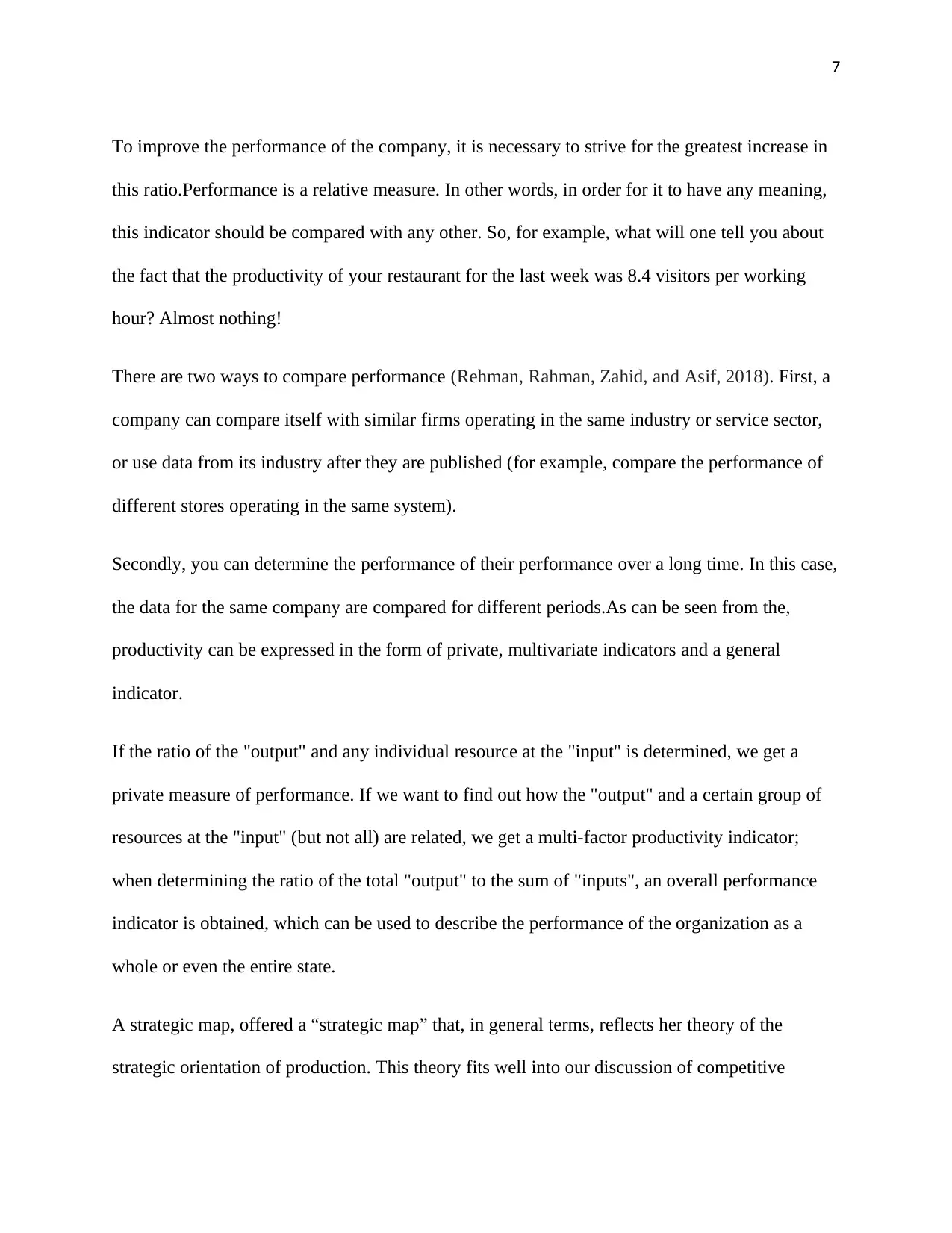
7
To improve the performance of the company, it is necessary to strive for the greatest increase in
this ratio.Performance is a relative measure. In other words, in order for it to have any meaning,
this indicator should be compared with any other. So, for example, what will one tell you about
the fact that the productivity of your restaurant for the last week was 8.4 visitors per working
hour? Almost nothing!
There are two ways to compare performance (Rehman, Rahman, Zahid, and Asif, 2018). First, a
company can compare itself with similar firms operating in the same industry or service sector,
or use data from its industry after they are published (for example, compare the performance of
different stores operating in the same system).
Secondly, you can determine the performance of their performance over a long time. In this case,
the data for the same company are compared for different periods.As can be seen from the,
productivity can be expressed in the form of private, multivariate indicators and a general
indicator.
If the ratio of the "output" and any individual resource at the "input" is determined, we get a
private measure of performance. If we want to find out how the "output" and a certain group of
resources at the "input" (but not all) are related, we get a multi-factor productivity indicator;
when determining the ratio of the total "output" to the sum of "inputs", an overall performance
indicator is obtained, which can be used to describe the performance of the organization as a
whole or even the entire state.
A strategic map, offered a “strategic map” that, in general terms, reflects her theory of the
strategic orientation of production. This theory fits well into our discussion of competitive
To improve the performance of the company, it is necessary to strive for the greatest increase in
this ratio.Performance is a relative measure. In other words, in order for it to have any meaning,
this indicator should be compared with any other. So, for example, what will one tell you about
the fact that the productivity of your restaurant for the last week was 8.4 visitors per working
hour? Almost nothing!
There are two ways to compare performance (Rehman, Rahman, Zahid, and Asif, 2018). First, a
company can compare itself with similar firms operating in the same industry or service sector,
or use data from its industry after they are published (for example, compare the performance of
different stores operating in the same system).
Secondly, you can determine the performance of their performance over a long time. In this case,
the data for the same company are compared for different periods.As can be seen from the,
productivity can be expressed in the form of private, multivariate indicators and a general
indicator.
If the ratio of the "output" and any individual resource at the "input" is determined, we get a
private measure of performance. If we want to find out how the "output" and a certain group of
resources at the "input" (but not all) are related, we get a multi-factor productivity indicator;
when determining the ratio of the total "output" to the sum of "inputs", an overall performance
indicator is obtained, which can be used to describe the performance of the organization as a
whole or even the entire state.
A strategic map, offered a “strategic map” that, in general terms, reflects her theory of the
strategic orientation of production. This theory fits well into our discussion of competitive
Paraphrase This Document
Need a fresh take? Get an instant paraphrase of this document with our AI Paraphraser
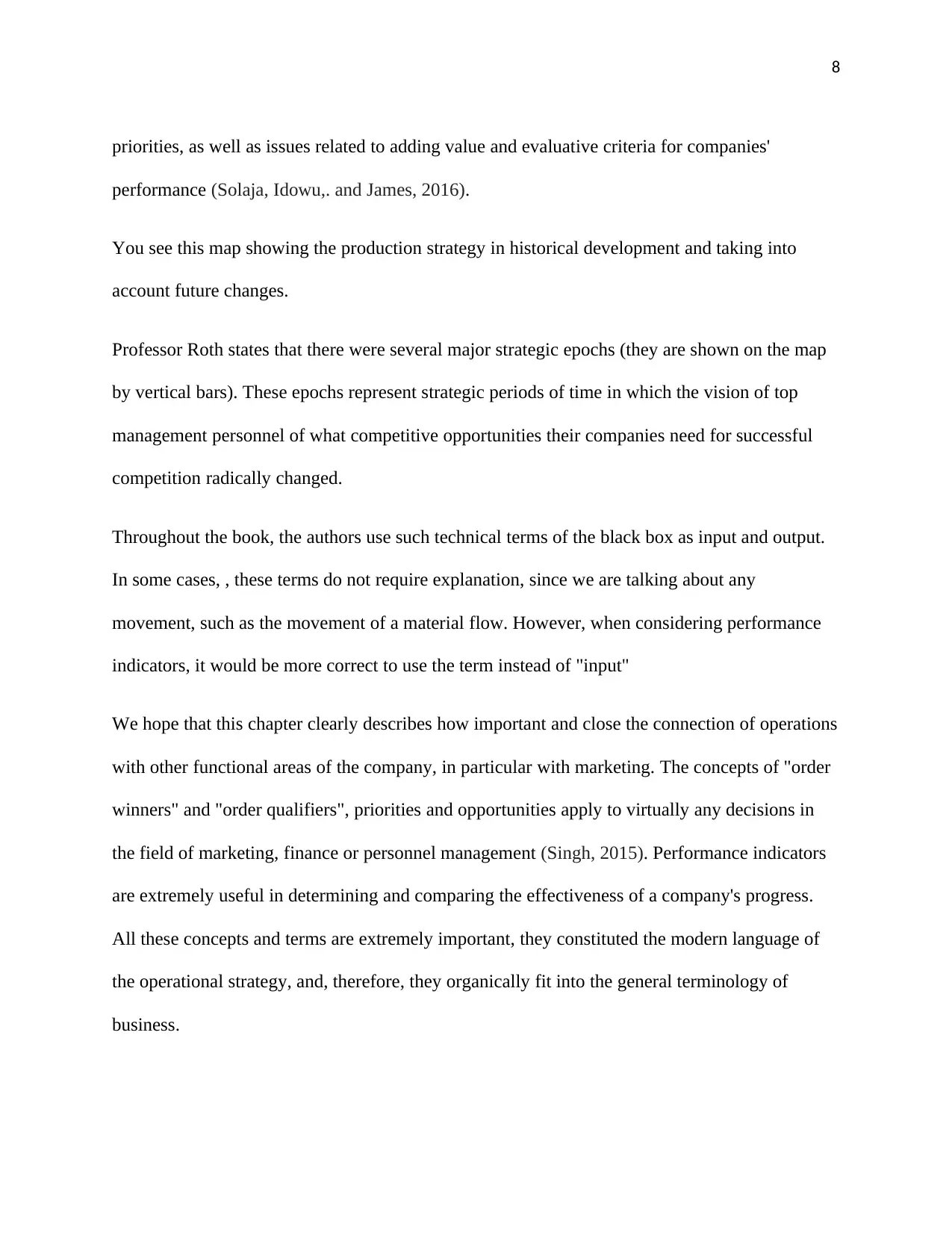
8
priorities, as well as issues related to adding value and evaluative criteria for companies'
performance (Solaja, Idowu,. and James, 2016).
You see this map showing the production strategy in historical development and taking into
account future changes.
Professor Roth states that there were several major strategic epochs (they are shown on the map
by vertical bars). These epochs represent strategic periods of time in which the vision of top
management personnel of what competitive opportunities their companies need for successful
competition radically changed.
Throughout the book, the authors use such technical terms of the black box as input and output.
In some cases, , these terms do not require explanation, since we are talking about any
movement, such as the movement of a material flow. However, when considering performance
indicators, it would be more correct to use the term instead of "input"
We hope that this chapter clearly describes how important and close the connection of operations
with other functional areas of the company, in particular with marketing. The concepts of "order
winners" and "order qualifiers", priorities and opportunities apply to virtually any decisions in
the field of marketing, finance or personnel management (Singh, 2015). Performance indicators
are extremely useful in determining and comparing the effectiveness of a company's progress.
All these concepts and terms are extremely important, they constituted the modern language of
the operational strategy, and, therefore, they organically fit into the general terminology of
business.
priorities, as well as issues related to adding value and evaluative criteria for companies'
performance (Solaja, Idowu,. and James, 2016).
You see this map showing the production strategy in historical development and taking into
account future changes.
Professor Roth states that there were several major strategic epochs (they are shown on the map
by vertical bars). These epochs represent strategic periods of time in which the vision of top
management personnel of what competitive opportunities their companies need for successful
competition radically changed.
Throughout the book, the authors use such technical terms of the black box as input and output.
In some cases, , these terms do not require explanation, since we are talking about any
movement, such as the movement of a material flow. However, when considering performance
indicators, it would be more correct to use the term instead of "input"
We hope that this chapter clearly describes how important and close the connection of operations
with other functional areas of the company, in particular with marketing. The concepts of "order
winners" and "order qualifiers", priorities and opportunities apply to virtually any decisions in
the field of marketing, finance or personnel management (Singh, 2015). Performance indicators
are extremely useful in determining and comparing the effectiveness of a company's progress.
All these concepts and terms are extremely important, they constituted the modern language of
the operational strategy, and, therefore, they organically fit into the general terminology of
business.
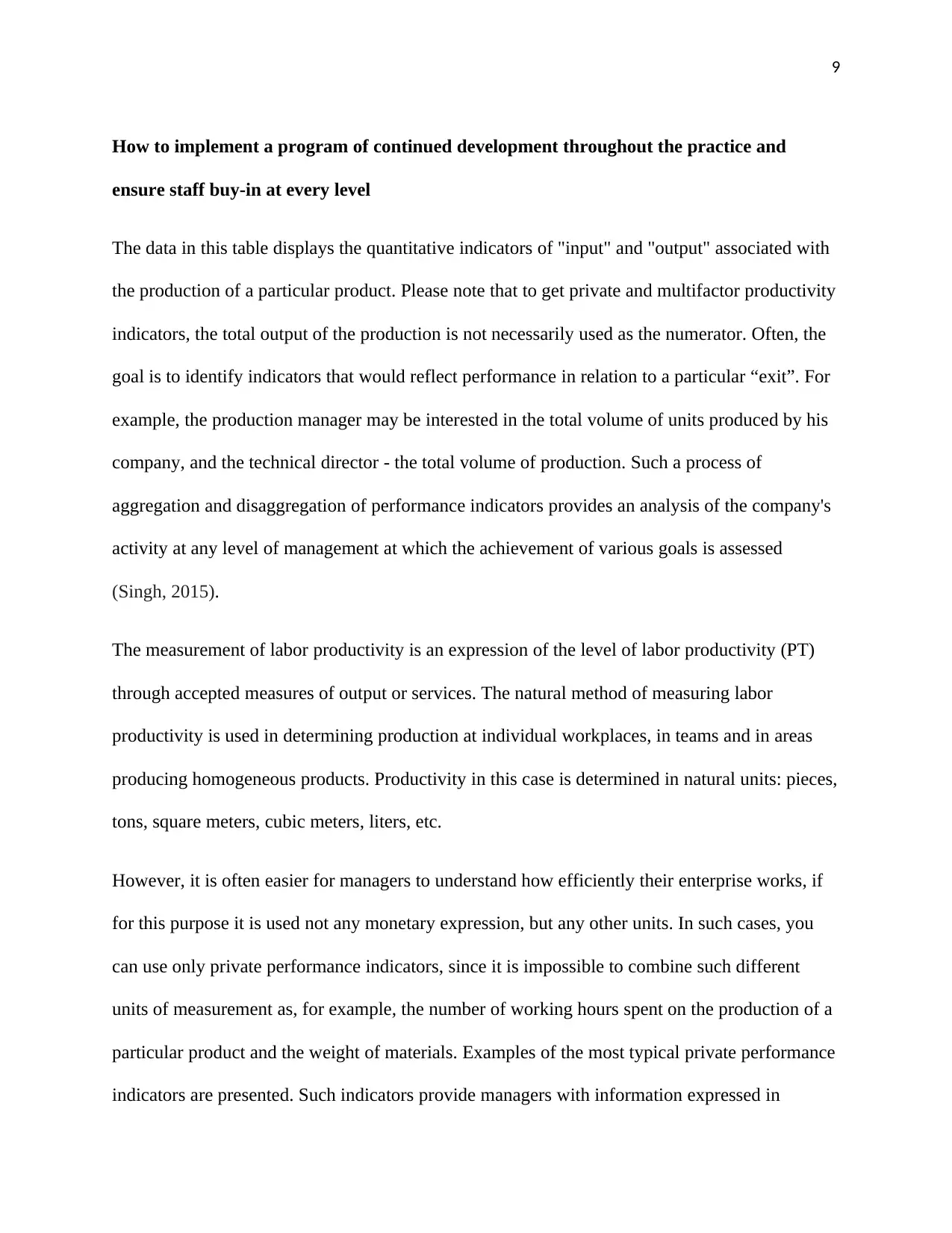
9
How to implement a program of continued development throughout the practice and
ensure staff buy-in at every level
The data in this table displays the quantitative indicators of "input" and "output" associated with
the production of a particular product. Please note that to get private and multifactor productivity
indicators, the total output of the production is not necessarily used as the numerator. Often, the
goal is to identify indicators that would reflect performance in relation to a particular “exit”. For
example, the production manager may be interested in the total volume of units produced by his
company, and the technical director - the total volume of production. Such a process of
aggregation and disaggregation of performance indicators provides an analysis of the company's
activity at any level of management at which the achievement of various goals is assessed
(Singh, 2015).
The measurement of labor productivity is an expression of the level of labor productivity (PT)
through accepted measures of output or services. The natural method of measuring labor
productivity is used in determining production at individual workplaces, in teams and in areas
producing homogeneous products. Productivity in this case is determined in natural units: pieces,
tons, square meters, cubic meters, liters, etc.
However, it is often easier for managers to understand how efficiently their enterprise works, if
for this purpose it is used not any monetary expression, but any other units. In such cases, you
can use only private performance indicators, since it is impossible to combine such different
units of measurement as, for example, the number of working hours spent on the production of a
particular product and the weight of materials. Examples of the most typical private performance
indicators are presented. Such indicators provide managers with information expressed in
How to implement a program of continued development throughout the practice and
ensure staff buy-in at every level
The data in this table displays the quantitative indicators of "input" and "output" associated with
the production of a particular product. Please note that to get private and multifactor productivity
indicators, the total output of the production is not necessarily used as the numerator. Often, the
goal is to identify indicators that would reflect performance in relation to a particular “exit”. For
example, the production manager may be interested in the total volume of units produced by his
company, and the technical director - the total volume of production. Such a process of
aggregation and disaggregation of performance indicators provides an analysis of the company's
activity at any level of management at which the achievement of various goals is assessed
(Singh, 2015).
The measurement of labor productivity is an expression of the level of labor productivity (PT)
through accepted measures of output or services. The natural method of measuring labor
productivity is used in determining production at individual workplaces, in teams and in areas
producing homogeneous products. Productivity in this case is determined in natural units: pieces,
tons, square meters, cubic meters, liters, etc.
However, it is often easier for managers to understand how efficiently their enterprise works, if
for this purpose it is used not any monetary expression, but any other units. In such cases, you
can use only private performance indicators, since it is impossible to combine such different
units of measurement as, for example, the number of working hours spent on the production of a
particular product and the weight of materials. Examples of the most typical private performance
indicators are presented. Such indicators provide managers with information expressed in
⊘ This is a preview!⊘
Do you want full access?
Subscribe today to unlock all pages.

Trusted by 1+ million students worldwide
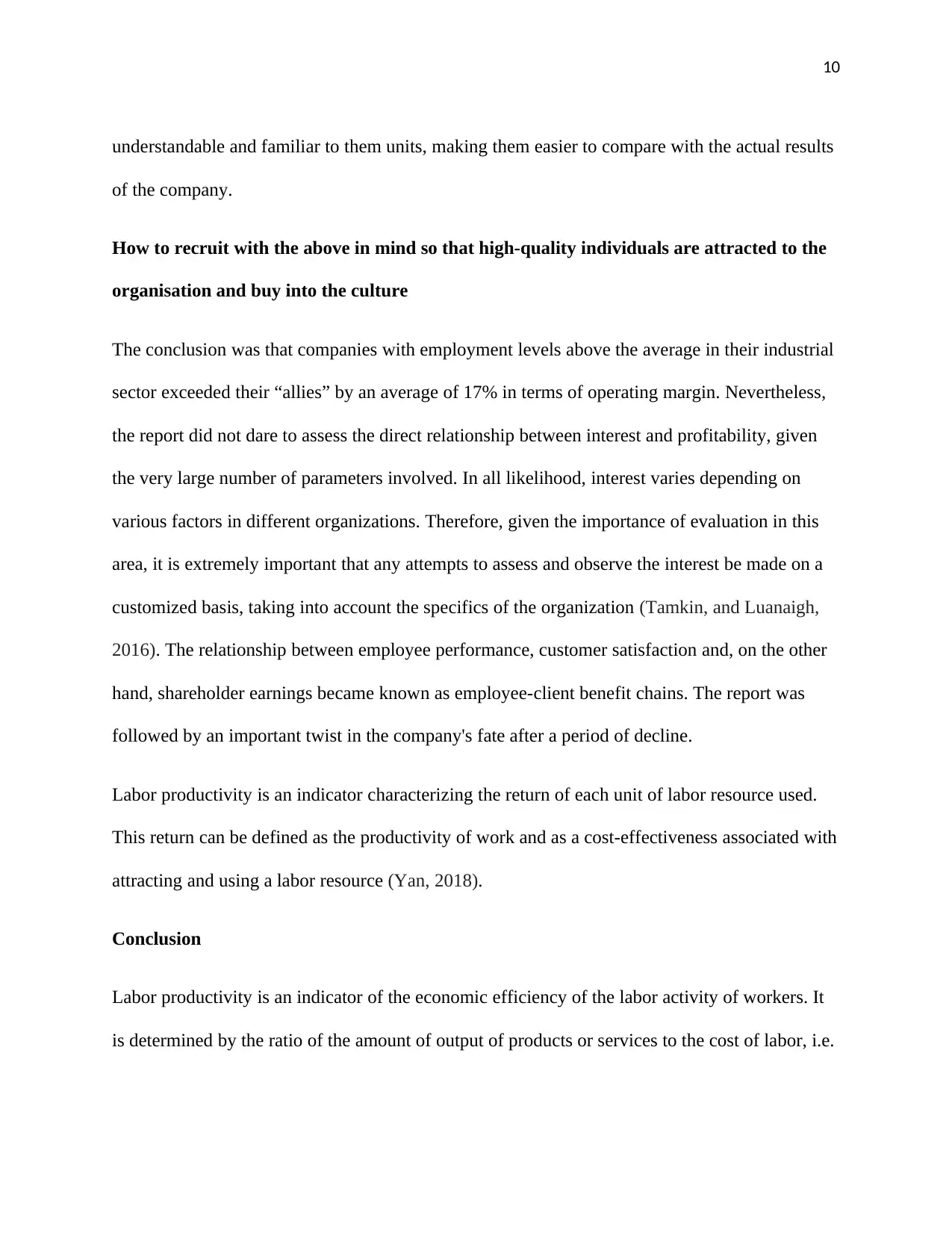
10
understandable and familiar to them units, making them easier to compare with the actual results
of the company.
How to recruit with the above in mind so that high-quality individuals are attracted to the
organisation and buy into the culture
The conclusion was that companies with employment levels above the average in their industrial
sector exceeded their “allies” by an average of 17% in terms of operating margin. Nevertheless,
the report did not dare to assess the direct relationship between interest and profitability, given
the very large number of parameters involved. In all likelihood, interest varies depending on
various factors in different organizations. Therefore, given the importance of evaluation in this
area, it is extremely important that any attempts to assess and observe the interest be made on a
customized basis, taking into account the specifics of the organization (Tamkin, and Luanaigh,
2016). The relationship between employee performance, customer satisfaction and, on the other
hand, shareholder earnings became known as employee-client benefit chains. The report was
followed by an important twist in the company's fate after a period of decline.
Labor productivity is an indicator characterizing the return of each unit of labor resource used.
This return can be defined as the productivity of work and as a cost-effectiveness associated with
attracting and using a labor resource (Yan, 2018).
Conclusion
Labor productivity is an indicator of the economic efficiency of the labor activity of workers. It
is determined by the ratio of the amount of output of products or services to the cost of labor, i.e.
understandable and familiar to them units, making them easier to compare with the actual results
of the company.
How to recruit with the above in mind so that high-quality individuals are attracted to the
organisation and buy into the culture
The conclusion was that companies with employment levels above the average in their industrial
sector exceeded their “allies” by an average of 17% in terms of operating margin. Nevertheless,
the report did not dare to assess the direct relationship between interest and profitability, given
the very large number of parameters involved. In all likelihood, interest varies depending on
various factors in different organizations. Therefore, given the importance of evaluation in this
area, it is extremely important that any attempts to assess and observe the interest be made on a
customized basis, taking into account the specifics of the organization (Tamkin, and Luanaigh,
2016). The relationship between employee performance, customer satisfaction and, on the other
hand, shareholder earnings became known as employee-client benefit chains. The report was
followed by an important twist in the company's fate after a period of decline.
Labor productivity is an indicator characterizing the return of each unit of labor resource used.
This return can be defined as the productivity of work and as a cost-effectiveness associated with
attracting and using a labor resource (Yan, 2018).
Conclusion
Labor productivity is an indicator of the economic efficiency of the labor activity of workers. It
is determined by the ratio of the amount of output of products or services to the cost of labor, i.e.
Paraphrase This Document
Need a fresh take? Get an instant paraphrase of this document with our AI Paraphraser

11
the production per unit of labor costs, or the amount of time spent per unit of production, i.e.
labor intensiveness.
the production per unit of labor costs, or the amount of time spent per unit of production, i.e.
labor intensiveness.
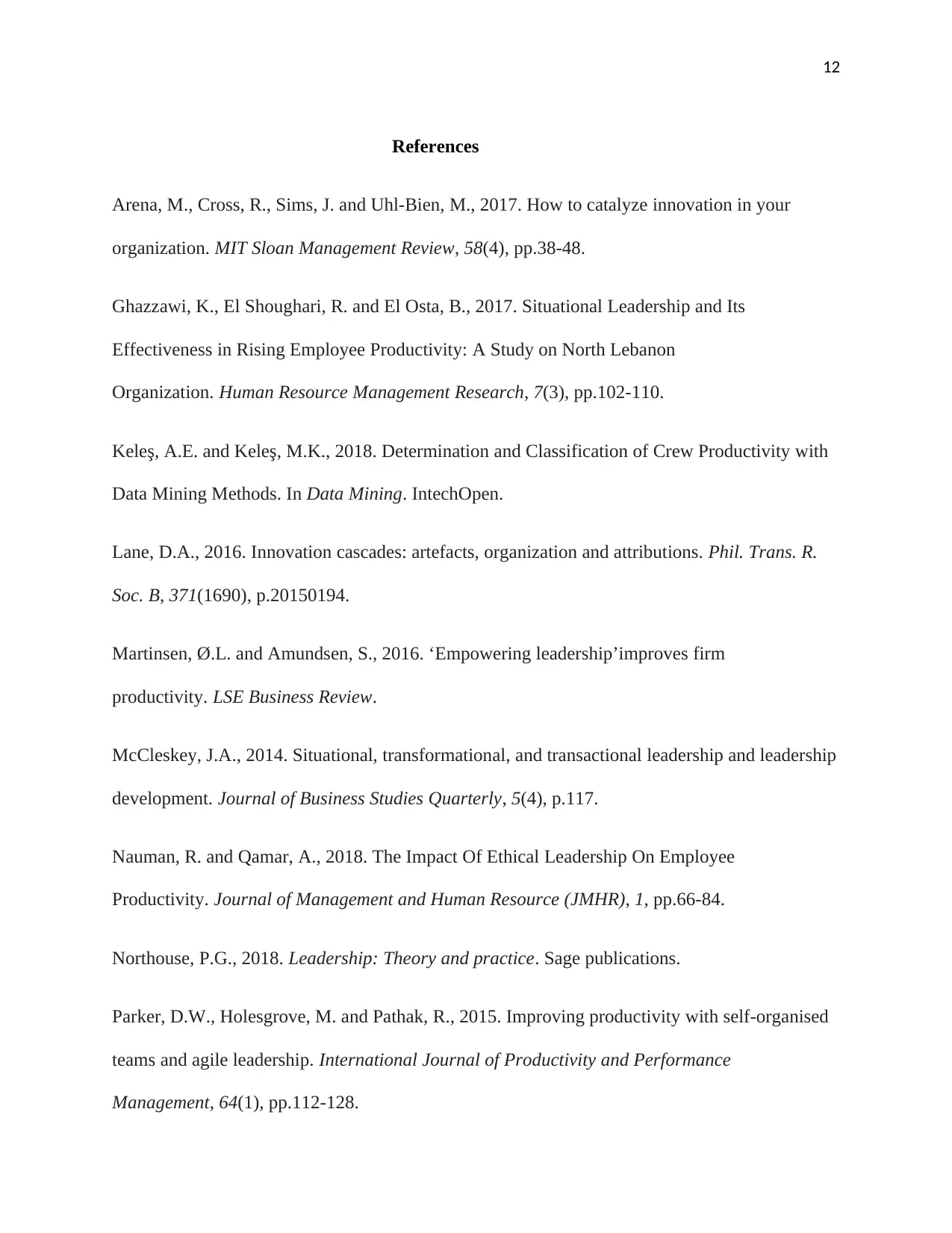
12
References
Arena, M., Cross, R., Sims, J. and Uhl-Bien, M., 2017. How to catalyze innovation in your
organization. MIT Sloan Management Review, 58(4), pp.38-48.
Ghazzawi, K., El Shoughari, R. and El Osta, B., 2017. Situational Leadership and Its
Effectiveness in Rising Employee Productivity: A Study on North Lebanon
Organization. Human Resource Management Research, 7(3), pp.102-110.
Keleş, A.E. and Keleş, M.K., 2018. Determination and Classification of Crew Productivity with
Data Mining Methods. In Data Mining. IntechOpen.
Lane, D.A., 2016. Innovation cascades: artefacts, organization and attributions. Phil. Trans. R.
Soc. B, 371(1690), p.20150194.
Martinsen, Ø.L. and Amundsen, S., 2016. ‘Empowering leadership’improves firm
productivity. LSE Business Review.
McCleskey, J.A., 2014. Situational, transformational, and transactional leadership and leadership
development. Journal of Business Studies Quarterly, 5(4), p.117.
Nauman, R. and Qamar, A., 2018. The Impact Of Ethical Leadership On Employee
Productivity. Journal of Management and Human Resource (JMHR), 1, pp.66-84.
Northouse, P.G., 2018. Leadership: Theory and practice. Sage publications.
Parker, D.W., Holesgrove, M. and Pathak, R., 2015. Improving productivity with self-organised
teams and agile leadership. International Journal of Productivity and Performance
Management, 64(1), pp.112-128.
References
Arena, M., Cross, R., Sims, J. and Uhl-Bien, M., 2017. How to catalyze innovation in your
organization. MIT Sloan Management Review, 58(4), pp.38-48.
Ghazzawi, K., El Shoughari, R. and El Osta, B., 2017. Situational Leadership and Its
Effectiveness in Rising Employee Productivity: A Study on North Lebanon
Organization. Human Resource Management Research, 7(3), pp.102-110.
Keleş, A.E. and Keleş, M.K., 2018. Determination and Classification of Crew Productivity with
Data Mining Methods. In Data Mining. IntechOpen.
Lane, D.A., 2016. Innovation cascades: artefacts, organization and attributions. Phil. Trans. R.
Soc. B, 371(1690), p.20150194.
Martinsen, Ø.L. and Amundsen, S., 2016. ‘Empowering leadership’improves firm
productivity. LSE Business Review.
McCleskey, J.A., 2014. Situational, transformational, and transactional leadership and leadership
development. Journal of Business Studies Quarterly, 5(4), p.117.
Nauman, R. and Qamar, A., 2018. The Impact Of Ethical Leadership On Employee
Productivity. Journal of Management and Human Resource (JMHR), 1, pp.66-84.
Northouse, P.G., 2018. Leadership: Theory and practice. Sage publications.
Parker, D.W., Holesgrove, M. and Pathak, R., 2015. Improving productivity with self-organised
teams and agile leadership. International Journal of Productivity and Performance
Management, 64(1), pp.112-128.
⊘ This is a preview!⊘
Do you want full access?
Subscribe today to unlock all pages.

Trusted by 1+ million students worldwide
1 out of 13
Related Documents
Your All-in-One AI-Powered Toolkit for Academic Success.
+13062052269
info@desklib.com
Available 24*7 on WhatsApp / Email
![[object Object]](/_next/static/media/star-bottom.7253800d.svg)
Unlock your academic potential
Copyright © 2020–2025 A2Z Services. All Rights Reserved. Developed and managed by ZUCOL.



